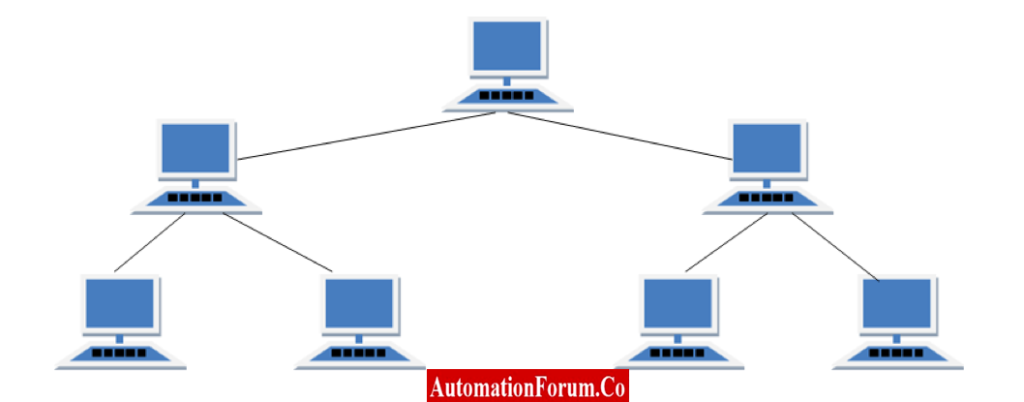Network Topologies
A network’s topology can be defined as its logical arrangement or layout, as well as a description of how its various nodes (senders and receivers) are connected to one another and communicate with one another.
Network Topology refers to the locations of computers and how the cable is run between them.
Types of Network Topology
- Bus topology
- Ring topology
- Star topology
- Mesh topology
- Tree topology
- Hybrid topology
Bus Topology
All of the computer nodes and the network system are connected to a single transmission channel in a bus topology network. This type of network is also known as a bus topology.
The computers connected in bus topology only listen to the data being sent and not responsible for moving data from one computer to the next therefore the bus topology is also called as a passive topology.

Types of Bus Topology
Linear Bus topology: When a bus topology is linear, there are precisely two terminals.
Distributed bus topology: When a bus has more than two endpoints, it has a distributed topology.
Features of Bus Topology
1. It only transmits data in one direction.
2. The node/system and the channel are connected by a single cable.
Bus Topology Advantages and Disadvantages
Advantages of Bus topology
- It’s basic, easy to understand, and simple.
- Small network dependability
- The bus connects the PCs with the least amount of cable and is therefore less expensive than other cabling setups.
- The network as a whole is not affected by the failure of one node
Disadvantages of Bus topology
- There is a maximum cable length. The number of stations that can be joined is constrained by this.
- Only a small number of nodes can effectively use this network structure.
- An extremely busy network can make a bus move very slowly.
- A cable break or improper termination can cause the network to go down.
- A bus is challenging to troubleshoot.
- The network will not function if the backbone cable fails.
- There is no two-way communication.
Real Time Application of Bus Topology
Single-line bus topology connects two floors. In this topology, one machine is a server and the other a client. The server transfers data between client computers.
Ring Topology
In a Ring topology, the devices are arranged in the shape of a ring, and each device is connected point-to-point to its neighbor on both sides. Additionally, the first and last nodes in the ring are connected to one another.
As no termination, this topology is active topology.

The functionality of Ring topology
- The management of the operation will be handled by a single device in this topology, which will be referred to as the monitor station.
- In order to send data, the station needs to have possession of the token.
- If there is no station that currently has the token, it will be passed around the ring until one of the stations claims it.
Features of Ring topology
- A number of repeaters have been placed throughout the network in order to ensure that there is no loss of data during transmission from the first node to the last node, say, the 1000th node. The network must function normally even when under a lot of strain.
- A higher-speed network is required.
- Dual Ring Topology has connections in both directions between all of the network nodes
- Because the data is sent in a sequential fashion, devices cannot be skipped in between transmissions.
- There won’t be a lot of network configuration changes.
Ring network topology Advantages and Disadvantages
Advantages of Ring Topology
- Each intermediary node is traversed by the data being transferred between the two nodes.
- To manage this topology, no central server is necessary.
- The network is open to all computers equally.
- Network performance is even when there are many users.
Disadvantages of Ring Topology.
- The entire network may fall if only one node of it failed
- Performance of the overall network is affected by node movement or configuration changes.
- The ring network is challenging to debug.
Real Time Application of Ring Topology
A ring network topology is suitable for a small office with only a few nodes.
Star Topology
In the star topology, each of the computers has a cable that connects it to a single hub, which is the central node of the network. This central node is called a hub/ server/ host. Each computer communicates with central hub that reseeds the message to appropriate computer. Also, this hub is called multiport repeater.
There are two types of hub either active hub or passive hub. In active hub, the hub regenerates the electrical signal and sends it to all the computers connected to it.
The function of a passive hub, such as wiring panels, is limited to providing a connection; it does not enhance or regenerate the signal. The operation of a passive hub does not require power

Features of the Star Topology
- It must be easy to make change in the client computer.
- It must be easy to troubleshoot.
- The network is large.
Star network topology advantages and disadvantages
Advantages of Star Topology
- The topology enables ease of operation because it is centralized. Additionally, it succeeds in isolating every network device.
- A node network can continue to run normally throughout addition or deletion.
- If the central hub’s capacity is reached, it can be swapped out for one with more ports for connecting lines.
- A single computer failure need not bring the entire star network to a stop.
Disadvantage of Star Topology
- The central hub’s functionality is necessary for the network to operate. As a result, when the central hub fails, the entire network also fails.
- The expense to cable a star network was higher. must have a dedicated server
Real Time Application of Star Topology
Airports, hospitals, banks, and schools use star topology. Switches can replace Hubs as core devices.
Mesh Topology
Every computer in a mesh topology is connected to every other computer through channels that are solely dedicated to those connections.
Features of the Mesh Topology
Each device needs N minus one of the total available ports in order to function properly. (if there are five devices connected, then you will need four ports) N*(N-1)/2 is the total number of dedicated links that are necessary in order to connect them. Therefore, if there are five computers connected to it, the required number of dedicated links will be five times four and a half, which is ten.

It comes in two categories
- A mesh topology with all nodes fully connected to one another.
- Mesh topology that is only partially connected: Not all of the nodes are linked together.
Types of Mesh Topology
Partial Mesh Topology
In this topology, some systems are connected similarly to how mesh topology is connected, however some devices are only connected to two or three other devices.
Full Mesh Topology
Every node or device is connected to every other node or device.
Advantages and Disadvantages of Mesh network topology
Advantage of Mesh Topology
• Due to the way, the network nodes are configured, data can be sent simultaneously from one node to a large number of other nodes.
Disadvantage of Mesh Topology
- Every network node is connected to every other node in the network, even though many of those connections are unnecessary. As a result, many of the network connections become redundant.
- It is pricey because of the quantity of cabling and input/output ports.
- Running the cables requires a lot of space.
Real Time Application of Mesh Topology
Initially in military appliances. Recently in-home automation, smart HVAC control and smart buildings.
Tree Topology
Because it has components from both the linear bus and the star topologies, this form of topology is also referred to as a hybrid topology. There are at least three different tiers present.

Features of Tree Topology
- Typically used in WAN
- It is best if workstations are arranged in clusters.
- Applied to wide-area networks
Advantages and Disadvantages of Tree Topology
Advantages of Tree Topology
- It’s simple to add a computer to a node.
- Simpler maintenance and fault discovery.
- Characteristics of bus and star topologies.
Disadvantages of Tree Topology
- Requires a lot of cable.
- Expensive to implement.
- If the root node fails, the entire network will crash and its processing will end.
Real Time Application of Tree Topology
Home and small business printers and computers are typically connected using tree topology. Bus networks use tree topology to connect devices to a central server.
Tree topologies can link bus and star topologies to a larger, system-wide architecture while maintaining the hierarchical structure few businesses need. Tree topology is used to organize the computers in corporate network.
Hybrid Topology
A hybrid topology combines two or more different network topology types. It is typically put into practice by the organization. For instance, if ring topology is utilized in one office department and star topology is used in another, connecting both topologies will provide a hybrid topology (ring topology and star topology).

Features of Hybrid Topology
Collection of two or more topologies is one of hybrid topology’s characteristics.
Hybrid network topology advantages and disadvantages
Advantages of Hybrid Topology
- Reliable since troubleshooting and error detecting are simple.
- Effective.
- Scalable, as size may be simply increased.
- Flexible.
Disadvantages of Hybrid Topology
- A complicated design.
- Costly.
Real Time Application of Hybrid Topology
- The largest Hybrid topology is Internet
- If there is a bus topology in the IT department while ring topology in the HR department then connecting these two will result in the hybrid topology.





